How can electric cars power your home and the electricity grid? What is bidirectional charging and how does it work? What are the differences between V2G, V2H and V2L?
We are currently undergoing a fundamental shift in the way energy is produced and used, known as the “energy transition”. The move from centrally generated fossil fuels (coal, oil and gas) to distributed, but intermittent, renewable energy (sun, wind) presents some challenges.
Notably, what happens when the sun isn’t shining or the wind stops? We can continue to fire up gas-fired power plants or we can store the excess renewable energy in hydroelectric dams and big batteries.
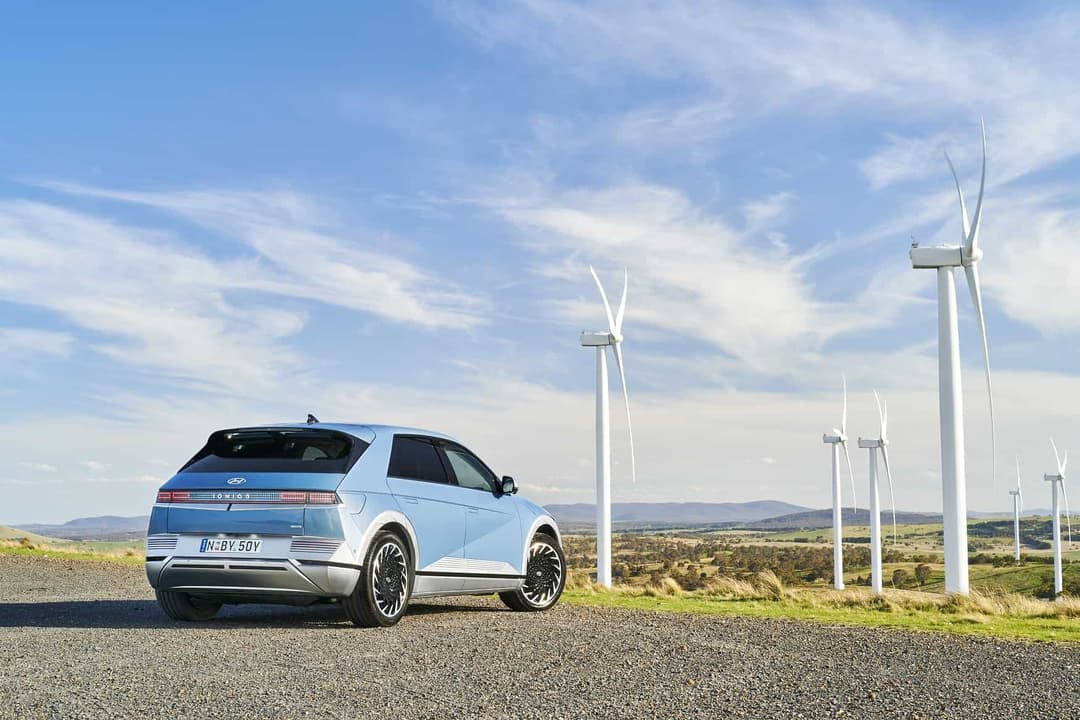
LEARN MORE
⚡ Which Electric Cars Have Bidirectional Charging (V2L, V2G, V2H)?
🔌 Everything You need To Know About Smart EV Charging
🔋 What are LFP, NMC, NCA Batteries in Electric Cars?
What if we didn't need to spend billions on big batteries – and instead harness the energy of an under-utilised car parked at home? Electric vehicles (EVs) are the answer, where through bidirectional charging, will form a core foundation of our future energy system in the near future.
In this ultimate guide, we’re going to cover everything you need to know about bidirectional charging in EVs, including:
- What it is and how it works;
- The different types and how you can benefit; and
- Which cars and chargers (now and in the future) are compatible.
What is Bidirectional Charging?
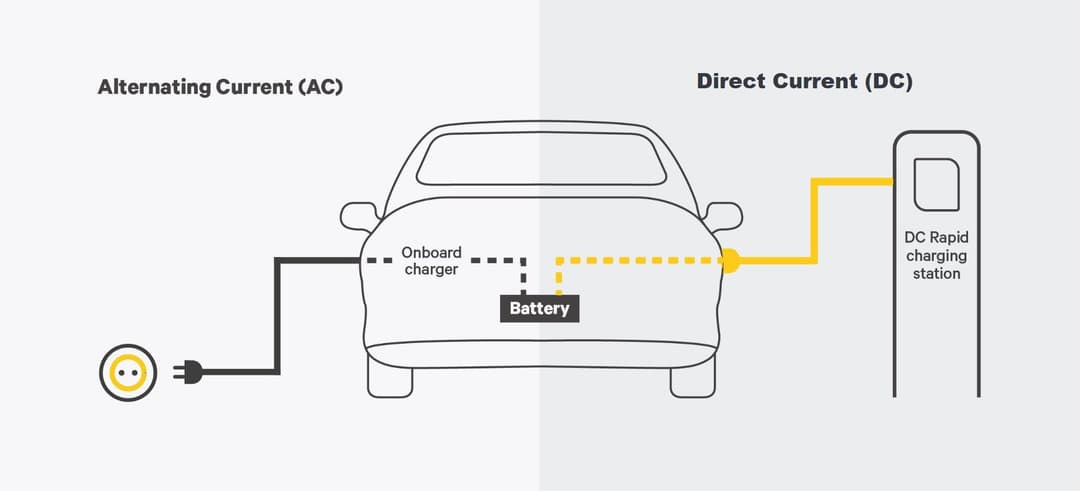
Electric Vehicle Charging Basics
When an EV is being charged, alternating current (AC) electricity from the grid is converted to direct current (DC) so it can be used by the car battery. This is done by a ‘convertor’ which is located in the car or in the charger. This is unidirectional charging, where energy flows one way from the grid to the car.
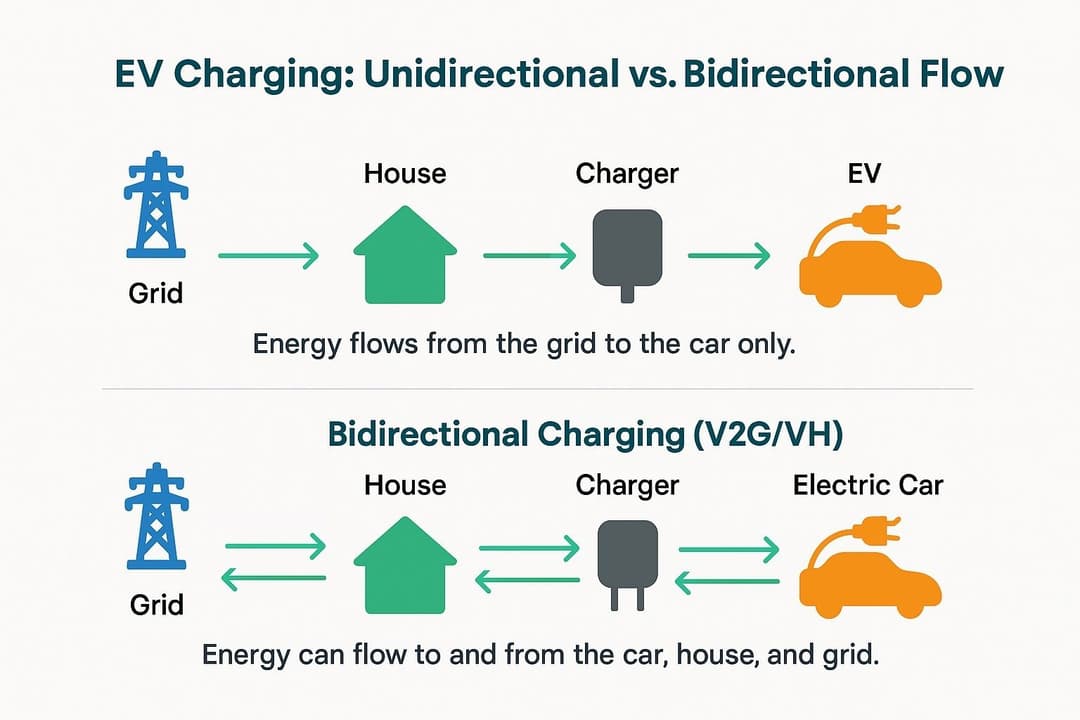
Bidirectional EV charging is essentially ‘charging’ that occurs two ways (back and forth). Energy will flow from the grid to the car or it can be sent back to the grid, building or power other devices.
Like a portable power bank used to charge your personal electronic devices, your electric vehicle can be used in the same way. In the case of EVs, the ‘devices’ are much larger – they could be a barbeque, your house or the electricity grid.
Bidirectional charging is the ‘umbrella’ term that covers several different use cases, with the most common being – V2G, V2H and V2L.
Vehicle to Grid, VtoG or V2G
V2G entails using energy from your EV to stabilise the grid. This is done through a ‘smart’ bidirectional charger, which is typically part of a VPP (Virtual Power Plant). Subject to defined parameters, your energy retailer will control when your battery is charged or discharged.
For example, your EV battery will be charged when energy demand is low; and discharged when demand is high. Scroll down to table 2 to see which cars are V2G compatible.
V2G will require the use of a compatible bidirectional charger such as the Wallbox Quasar.
Vehicle to Home, VtoH or V2H
V2H entails using energy from your EV to power your home or business. This works in the same way a stationary home storage battery (like the Tesla Powerwall 2) does in reducing grid consumption, except your car needs to be plugged into a bidirectional charge point.
You save money through ‘load shifting’; your EV is charged with cheap off-peak energy/solar and discharged at more expensive peak times.
V2H will require the use of a compatible bidirectional charger such as the Wallbox Quasar.
Vehicle to Load, VtoL or V2L
V2L is the most basic application of bidirectional charging. It does not require a bidirectional charger. Instead, a V2L adapter is plugged into your type 2 charging port which allows the car to operate as a portable battery pack with a standard 120/240V power supply.
This feature could be used on road trips (power a mini-fridge, bbq) or in the event of a power outage by providing temporary power to multiple devices. Scroll down to table 2 to see which cars are V2L compatible.
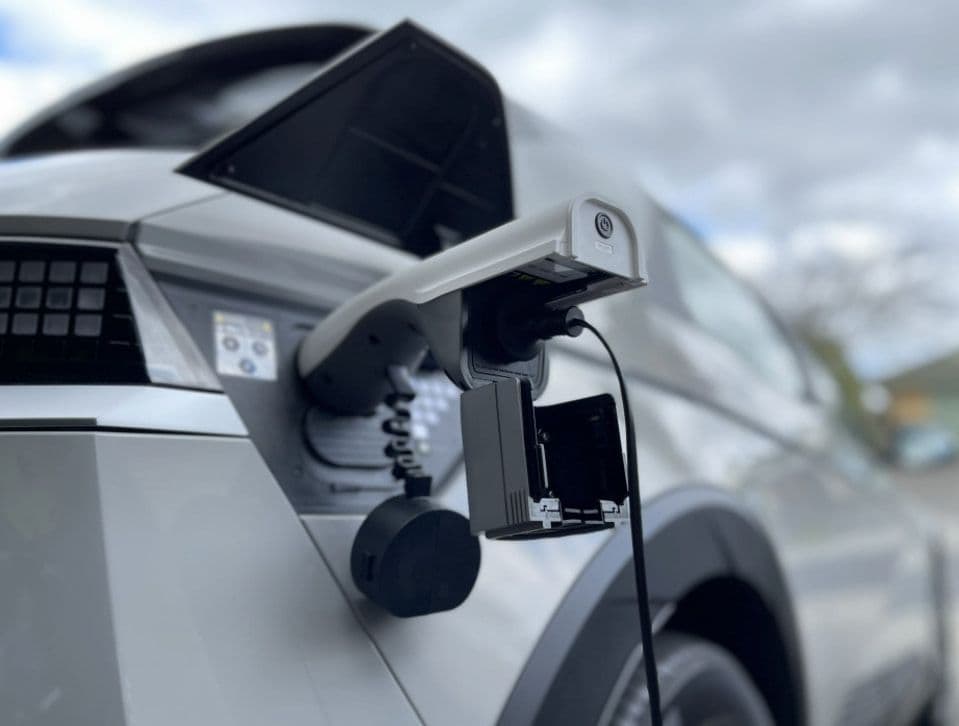
What are the Benefits of Bidirectional Charging?
The three main benefits made possible by directional charging include the ability to:
- Generate income via grid stabilization services;
- Cost savings via energy storage; and
- Energy independence via emergency backup power.
Generate Income via V2G
V2G will allow you to make money by providing services to the grid.
Your energy provider would charge your battery when demand is low and discharge when demand is high. You would be paid an agreed rate depending on the type and duration of service provided.
The chart below illustrates this manner of operation in an actual VPP pilot for stationary batteries. In principle, the application for EVs would be the same.
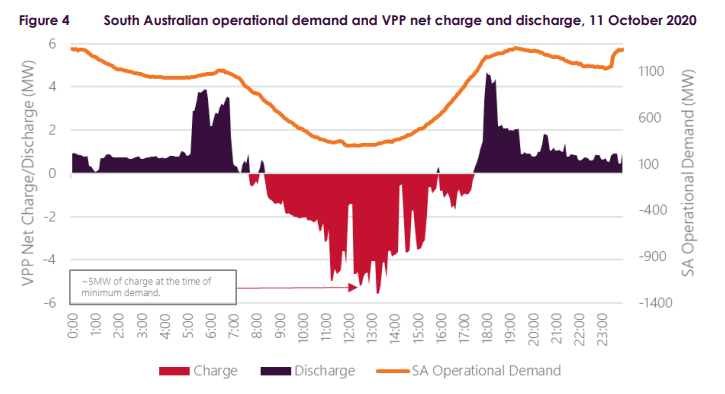
Given cars are idle 95 per cent of the time, when energy demand is high, it makes sense to harness the vast amount of energy capacity contained within EV high voltage battery packs.
The world’s largest V2G trial run by Ovo Energy and Cenex in the UK found that EV drivers could reduce their energy bills by up to £725 (A$1,347) a year via income received from providing grid services.
The project used the Nissan Leaf hatchback (ZE1) and the Quasar Wallbox bidirectional charger – the only capable product currently available.
A similar but smaller trial funded by ARENA called the REVS project is in the process of being completed. The results have yet to be released.
The UK pilot found that, although the benefits for the grid and the end-user were significant, hardware costs would need to fall dramatically for V2G to make financial sense for the masses.
JET Charge recently introduced the Quasar Wallbox to Australia, which retails for $10,000. For reference, you could purchase a 13.3 kWh Alphas ESS home storage battery and inverter for $10,000 installed.
Cost Savings via V2H
It’s evident that the ongoing running costs of owning an electric car are significantly lower than a petrol equivalent. This is due to substantially lower fuel costs and lower servicing and maintenance costs.
With bidirectional charging, you also have the option to lower your electricity costs by sending energy from your car battery to your home (V2H). Similarly to stationary batteries, you can employ load shifting to reduce your electricity bill.
Load shifting reduces your electricity bill by charging when energy is cheap and discharging when it is expensive.
The main limiting factor of using V2H is the need to always be plugged-in to the compatible bidirectional charging wallbox.
How Much Can You Save?
In the example below, we've compared the cost of owning a Hyundai Ioniq 5 (an EV with bidirectional capability) under two scenarios:
1. Transport only 🚗 - how we use a car today
2. Transport 🚗 + energy storage 🔋 - using your car as a battery (V2H)
Under the V2H scenario, it would take nearly 5 years to repay the additional cost of the bi-directional charger ($5,000), however once it is repaid you would pocket an extra $1,300 in electricity savings p.a. After 8-years you would be up about $5,000.
While the assumed $5,000 cost of the bi-directional charger may seem low compared to the $10,000 cost of the Quasar currently sold in Australia; just like solar panels and batteries the prices of these units will fall dramatically as production ramps up.
Utilisation of the car battery increases from 7% (driving) to 41% (driving and V2H), leaving significant unused capacity. What if we could also squeeze in some opportunities to power the grid via V2G?
Energy Independence and Backup Power

The other main benefit of bidirectional charging is the possibility of ‘energy independence’. This means reducing or eliminating your reliance on grid electricity.
Bidirectional charging will unlikely allow you to go completely off-grid, but it will reduce your grid energy use significantly.
In the above example, grid energy use is reduced by 70 per cent using V2H.
With the right equipment, you can set up a micro-grid at home which is essentially a mini power station. This would be particularly useful in the event of extended power outages.
A more basic application would be using V2L and plugging your key appliances such as your fridge, lights and television and using your EV's charging port.
In terms of off-grid energy systems (solar and batteries), bidirectional charging could reduce the size of home stationary storage batteries.
For example, instead of having multiple stationary batteries you may now only need one, as you can rely on your car battery for the remainder of the storage requirements.
Which Cars have Bidirectional Charging Capability?
Currently, only a handful of electric cars feature bidirectional charging. Several vehicles on the below list are compatible with V2L, but have yet to officially confirm future V2G/V2H compatibility.
The Nissan Leaf which uses the Chademo port is the first BEV to feature V2H and V2G capability. Outside of several pilots, we are yet to see commercial availability in everyday households and businesses.
With the Nissan Leaf set to be phased out by 2025 and confirmation of the upcoming Nissan Ariya featuring a CCS port, it is likely we will need to wait for the CCS standard to be finalised.
At present, there are several pilots being conducted globally testing the integration of the CCS standard. In Korea, V2G capability has already been incorporated into Hyundai Ioniq 5 and is currently being tested by Korea Electric Power Corporation.
Does Tesla have Bidirectional Charging V2L, V2G or V2H?
It has been rumoured that Tesla’s do have the hardware capable of facilitating bidirectional charging. Subsequent inspection however has confirmed that Tesla vehicles such as the Model 3 and Model Y do not have do not have bidirectional charging capability such as V2G or V2H.
Until the omission of bidirectional charging becomes detrimental to Tesla’s sales, it’s unlikely to feature on its pure-electric models. It would certainly cannibalise sales from its highly successful Powerwall home energy storage product, which has been on the market since 2015.
Does Bidirectional Charging Affect Battery Life?
Like the battery in your phone, every time your EV uses energy, there is a small amount of degradation.
Using your car as energy storage, in addition to everyday driving, will increase the number of cycles (a full charge and discharge). This would theoretically accelerate the degradation of your battery.
There is evidence to suggest that bidirectional discharging is less demanding on the battery than driving. The power intensity and volatility from driving creates more heat (one of the key drivers of degradation), rather than a lower constant load from bidirectional use. Not all cycles are equal.
In the event you want to use your EV for V2H or V2G, are the potential savings enough to justify the economic cost of battery degradation? We believe most likely.
From our previous example, using the car battery in a V2H context increases the number of charging cycles from 44 to 95 per annum.
The Cost of additional Degradation
Over eight years the ‘cost’ in terms of degradation is a 4.5 per cent reduction in the battery's state-of-health (SoH) from 97.9 per cent to 93.4 per cent.
Financial Benefits from Load Shifting
The economic benefit is a saving of $1,000 p.a. in reduced electricity bills, equating to $5,000 over eight years. Environmentally, you would reduce your carbon emissions footprint by a further 1387 kg p.a.
Is V2G or V2H a Worthwhile Investment?
Are the costs of degradation worth the benefits? To answer this we must quantify the costs of degradation. A 4.5 per cent reduction in the batteries state-of-health (SoH) translates to a loss in 3.3 kWh of energy capacity and 21km of range. To what degree will this adversely impact the future resale value?
There is no publicly available data we can rely on to know this answer conclusively. However, we can infer other data points to arrive at a rough conclusion.
Analysing data from zecar's EV database, the price per additional kWh between a ‘standard range’ and ‘extended range’ of two electric car models is $300 per kWh.
In today's terms, using the above metric as a proxy, the economic cost of degradation is approximately $1000. With V2H expected to save an additional $5000 over the 8-year ownership period, the economic case for V2H here is strong.
If you have the option to use your car as energy storage, we can infer from this case study with reasonable confidence that the economics of using your car in a V2H scenario make economic sense (we would welcome any data that proves otherwise).
As electric car prices continue to fall and if energy costs stay the same or increase, the argument for use as energy storage becomes even more compelling.
Is Bidirectional Charging Available in Australia?
Vehicle-to-load (V2L) is currently available in several of the latest models.
With regards to V2H and V2G, South Australia become the first jurisdiction in Australia to permit the connection of bidirectional chargers in its network. The only bidirectional charger approved to be used in bidirectional mode is the Wallbox Quasar which needs to be connected to a Nissan Leaf to activate the bidirectional charging feature. As of the time of writing, no other states in Australia have permitted the connection of bidirectional chargers in its network.
It should be noted that the Wallbox Quasar needs to be connected to a Nissan Leaf which uses the CHAdeMO plug which will not feature in any new electric cars going forward in Australia.
In Australia, the dominant charging plug is CCS, which is yet to feature an EV with V2H or V2G. CharIN e.V, the body in charge of driving commercialisation of V2G/V2H for the CCS standard, has set a roadmap for commercial availability by 2025. This means we are at least two to three years away from commercial availability of V2G and V2H in everyday commercial and household settings.
Frequently Asked Questions
About the author
Stay up to date with the latest EV news
- Get the latest news and update
- New EV model releases
- Get money savings-deal



